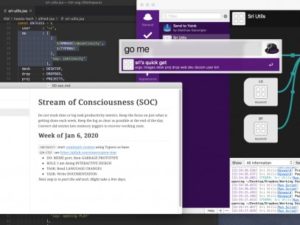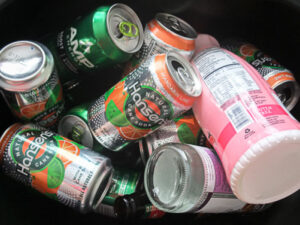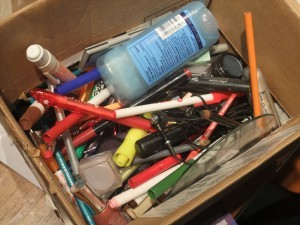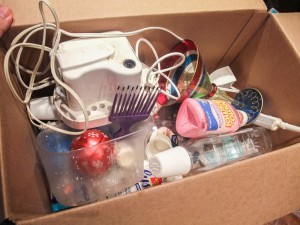(last edited on December 22, 2022 at 3:50 pm)
It’s the end of the third full week of using Trello as my main mid-to-high level task management system, handling task priorities at the day, week, and “would be nice” levels ranges of planning. This is the first time that I’ve had 100% continuity on my tasks, ranging from the short term to the long-term, for an extended period of time, in a form that is easy to take in with one sweeping glance. For the first time, I know exactly where I am in my journey of creative independence, whenever I want.
While this is pretty fantastic, a side effect has been the need to take time off. Before adopting Trello, I had an ambiguous sense of my long-term task list, and thus tended to work more reactively by just limiting my focus to one or two pressing things at a time. Now, I can see a lot more at once, and there is always something I can be doing. After three solid weeks of this, I started to feel oppressed by it and experience a massive productivity slump just before the holiday weekend.
The symptoms manifested as follows:
- An extreme difficulty in focusing moment to moment
- A restlessness that could not be fixed by napping, goofing off, watching TV, or even working.
- An increase in mindless net surfing and online shopping.
- A decrease in curiosity and energy despite the desire for new input
I’d experienced this before, and know that it eventually passes. This tends to be what happens when I’m burned out, but I couldn’t think of what possibly could be the cause. Burn out is caused by long periods of intense work under pressure, but the past month had been relaxing AND productive. Or so I thought.
It occurred to me that for the past three weeks, my mind has been constantly engaged in moving forward thanks to my Trello board. With Trello, it was suddenly much easier to find something to do that I knew was worthwhile, and checking the board several times a day had become a habit. It had become relentless.
Before Trello, my planning cycle consisted of talking 15-30 minutes to do a brain dump, followed by a quick assessment and selection of 2-3 things to focus on. This was an ephemeral and spontaneous way of doing it, carefree and well-suited to my freelance lifestyle. The plans, however, didn’t stick around, and I rarely checked them even when making a new plan. With Trello, though, I have a reliable up-to-date record of my hopes, dreams, and aspirations accessible 24-7. The plan had acquired the attribute of persistence, and now has its own life independent of my impromptu planning cycles. If the plan were to acquire self-awareness, it would have a clipboard and a comfortable mid-tier management role in my private corporation, cheerfully on the lookout for ways to exact a little more productivity out of the work day. Don’t get me wrong, it’s a great company to work for, with an ever-more focused vision steeped in the desire to ship excellent products some day, and Stan (because that would be it’s name) is a great guy who has good taste if not exceptional creativity. I’d trust Stan to borrow my car without hesitation, and I’m sure when I got it back he’d have topped off the tank and maybe put air in the tires. I like Stan. But sometimes I just gotta get away from his relentless desire to be productive.
So for the first time in a long while, I decreed that I was taking a break from thinking about the future.
That’s when I realized how bad I was at doing something else, like have fun. Stan’s at home spending time with his lovely family and planning a wonderful hiking trip in the White Mountains, and I’m in my living room office wondering what normal people do for “fun”. After a while, I gave up and just decided to get some yogurt at the Mall, which I hadn’t been to for a while.
As it turned out, it was just what I needed. Every time I go to the mall, I’m reminded that there are other people in the world leading very different lives. I spent some time wandering around, watching people engage with the world in their own way, reconnecting with what it meant to be a human being. I went to Barnes and Noble (picking up an issue of Mental Floss) and Trader Joe’s (indulging my love for weird foods in pretty boxes) afterwards, at which I was ready to go home and just veg for a bit. I also started reading Walter Isaacson’s biography of Steve Jobs, which my friend Alen had insisted that I read.
On Saturday, I went to buy Banh Mi (a kind of Vietnamese sandwich) and spent the rest of the day reading the Steve Jobs biography outside at Starbucks. Then I watched Jiro Dreams of Sushi on Amazon Prime Instant Video, which was a good segue from the biography. On Sunday, I slept in and ended up doing a bit of work on the ToyboxDX Phorum installation, collected garbage, and then headed to Starbucks (where I am now) to write up this blog post. I may stop by the supermarket to pick up something special to cook for Labor Day, though I have no plans to go out. Something savory, I think.
I haven’t looked at my Trello board since Friday. I keep thinking of it, and of the tasks on it, but I just need to keep away from it for a little while longer.






4 Comments
Same issue here. I would try any number of things to keep my ever growing list of things I want to do, which as soon as they were written down, no matter how far off in the future it would be or if it was just a want, became a pressing To Do List.
I decided to create, instead, a Nothing To Do List. In this list is where I would dump everything. Then I would close the program. And I would literally only look at it when I had run out of things to do. Since I’m a busy person anyway, it could be months before I’d look at the thing, and wouldn’t you know I’d end up deleting many items that actually weren’t that important or that I had done anyway because the task was important enough to me to stick in my brain.
For project braindumps (ideas I have that I literally need to organize NOW), I’ll actually use a mindmap software (I love SpicyNodes online). This allows me to braindump on a computer screen using an Outline-style format (my favorite) while also giving me the output of the stereotypical mindmap design when I want to see it live. I can also close the window on that as well, knowing that the ideas are organized and protected for when I want to visit them again.
Maybe this might help you. Perhaps all you need to do is take off the Perpetual column and move it to a place where you know it’s safe and accessible. Do you really need to look at everything you could be doing? I would say no – it’s a great way to create an unnecessary script for xanax IMO.
I started using it based on reading your post, and we’ll see if I stick with it – I can’t seem to stick to any kind of planning system, sigh – but I did like it for the way you set it up (momentum-based).
Sorry for rambling. :) Gower
David, are you still using Trello?
Michelle: I find that not using the perpetual column isn’t bothering me. I forgive myself daily for not getting everything I want done, and I think that’s been very helpful for me!
Nancy: Yes, I’m still using Trello, though not as actively because the number of third-party commitments has dropped a lot this month, and my planning focus shifted to using a daily text file that I copy from day-to-day (Feb and March are “challenge” months for specific themed tasks). However, I am using Trello to manage projects with other clients, so I have been referring to it more often lately.
Thanks, David, I can see how that could be useful with clients. I gave up on Trello, and on Evernote (for the, what? fourth time in five years??) and recently happily massaged GQueues into a format that I like. It’s integrated with Google calendar and has a simple outline structure with the ability to make multiple sub-tasks (just like a REAL outline! It doesn’t stop at one sub-task). Drag-and-drop to rearrange, much more flexible in that regard than Evernote. And I like being able to see everything listed in front of me (with the ability to hide stuff). Trello info is a little too hidden for me with ‘back of card’ stuff.